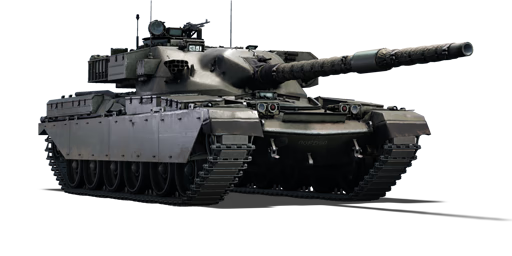

Ground Vehicles
Chieftain Mk 5
VI
Rank
AB
8.7
RB
8.7
SB
8.7
Battle rating
Great Britain
Research country
Medium tank
Main role
81,000

Research
450,000

Purchase
General information
Survivability and armour
Armour
front / side / back
Hull
86 / 38 / 25 mm
Turret
280 / 86 / 45 mm
Visibility
88 %
Crew
4 persons
Support systems
Mobility
Max speed
Forward
4853 km/h
Backward
1112 km/h
Power-to-weight ratio
13.812.226.421.4 hp/t
Engine power
7606721,4501,178 hp
Weight
55 t
Optics
Gunner
Commander
Driver
Optics zoom
7.0x–8.0x
1.0x–10.0x
—
Optical device
Armaments
120 mm Ordnance BL Tk. L11A5 cannon
Ammunition
54 rounds
First-order
17 rounds
Reload
basic crew → aces
9.7 → 7.5 s
Vertical guidance
-10 / 20°
Turret Rotation Speed
basic crew → aces
Horizontal
1411.926.419 → 201737.627.2 °/s
Vertical
3.52.812.27.8 → 5417.511.2 °/s
| Ammunition | Type | Armor penetration (mm) at a distance: | |||||
|---|---|---|---|---|---|---|---|
| 10 m | 100 m | 500 m | 1000 m | 1500 m | 2000 m | ||
| APDS | 298 | 296 | 288 | 277 | 268 | 258 | |
| HESH | 152 | 152 | 152 | 152 | 152 | 152 | |
| Smoke | 5 | 5 | 5 | 5 | 5 | 5 | |
12.7 mm L21A1 machine gun
Ammunition
588 rounds
Belt capacity
3 rounds
Reload
basic crew → aces
0.6 → 0.5 s
Fire rate
300 shots/min
| Belt | Belt filling | Armor penetration (mm) at a distance: | |||||
|---|---|---|---|---|---|---|---|
| 10 m | 100 m | 500 m | 1000 m | 1500 m | 2000 m | ||
| AI | 7 | 7 | 6 | 5 | 0 | 0 | |
7.62 mm L8A1 machine gun (coaxial)
Ammunition
6,000 rounds
Belt capacity
200 rounds
Reload
basic crew → aces
10.4 → 8 s
Fire rate
1,000 shots/min
| Belt | Belt filling | Armor penetration (mm) at a distance: | |||||
|---|---|---|---|---|---|---|---|
| 10 m | 100 m | 500 m | 1000 m | 1500 m | 2000 m | ||
| AP/AP/T | 13 | 12 | 7 | 3 | 2 | 0 | |
7.62 mm L37A1 machine gun
Ammunition
2,000 rounds
Belt capacity
100 rounds
Reload
basic crew → aces
10.4 → 8 s
Fire rate
650 shots/min
Vertical guidance
-10 / 50°
Turret Rotation Speed
basic crew → aces
Horizontal
6353.6118.685.7 → 9076.5169.4122.4 °/s
Vertical
6350.4220.5141.1 → 9072315201.6 °/s
| Belt | Belt filling | Armor penetration (mm) at a distance: | |||||
|---|---|---|---|---|---|---|---|
| 10 m | 100 m | 500 m | 1000 m | 1500 m | 2000 m | ||
| AP/AP/T | 13 | 12 | 7 | 3 | 2 | 0 | |
Economy
Repair cost
Basic → Reference
AB
4,420 → 6,100 

RB
4,581 → 6,322 

SB
5,671 → 7,826 

Crew training
130,000 

Experts
450,000 

Aces
2,000 

Research Aces
890,000 

Reward multiplier
AB / RB / SB
140 / 200 / 230 % 

214 % 

Total cost of modifications
129,200 

228,000 

Talisman cost
2,400 

Research order:
Mobility | |
|---|---|
Protection |
|---|
Firepower | ||
|---|---|---|
Rating by players
You must play more than 3 battles for the last week and more than 10 battles in a vehicle to rate it.
Like:
27
Armor protection:
Not enough ratings
Survivability:
Not enough ratings
Mobility:
Not enough ratings
Armament:
Not enough ratings
Balance:
Not enough ratings
Tips & Tricks
This space is currently empty
Do you know any interesting vehicle features?
Loading...
No articles about this vehicle yet
Become the first author and get rewards!
Write a guide, tell about interesting historical facts, make a tutorial or simply an interesting post.
No more content